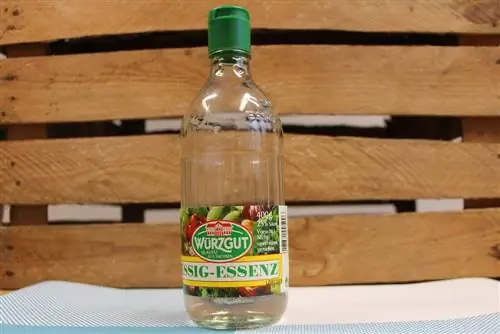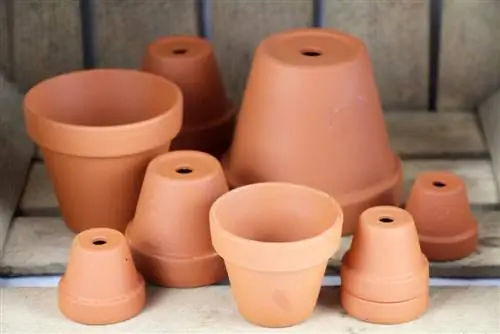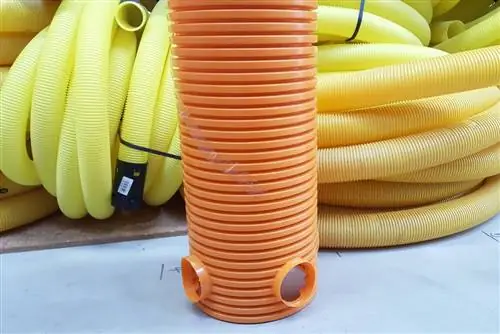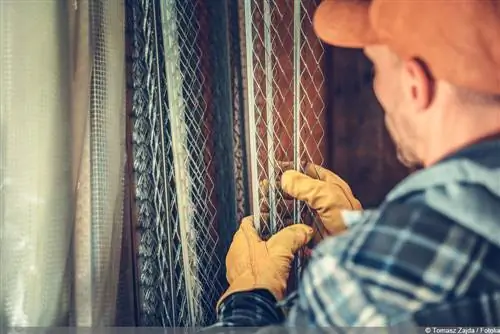- Author admin [email protected].
- Public 2023-12-17 03:39.
- Last modified 2025-06-01 06:48.
The well-maintained appearance of terracotta pots is limited by external influences. If unsightly limescale edges and a green patina form, this vintage look is not to everyone's taste. After treatment with simple home remedies, your valuable clay pots will look like they've been peeled off. This guide explains how to skillfully clean your flower pots. Benefit from these tips for the best care and cleaning.
What characterizes terracotta?
Terracotta flower pots are very popular with creative gardeners. Containers made of plastic, stone or concrete cannot match their authentic, Mediterranean flair. In addition, the special production from clay scores with a particular advantage for the growth and vitality of the plants in it. The German name is derived from the Italian “terra cotta” and literally means “burnt earth”.
In fact, terracotta pots are fired from clay at temperatures of up to 1,000 degrees Celsius over a period of around 24 hours. This process removes water from the pores so that the material hardens. A subsequent water bath of 2 to 3 hours not only cools the vessels, but also creates reliable weather and frost resistance. Nevertheless, the material remains slightly porous and therefore permeable to air. Therefore, the root balls of plants in terracotta pots do not wither as quickly as in flower pots made of plastic or glazed ceramic, even in full sunlight in midsummer.
It can be read again and again in publications that organic acid residues present in terracotta have a negative influence on plant growth. In fact, the reduction in the pH value in the substrate is hardly measurable. Furthermore, the already minimal acid accumulation is washed out through the porous pot wall with the irrigation water.
How do unwanted deposits arise?
A whitish or green patina begins to appear on new terracotta pots in the first garden and balcony season. We have summarized the most common causes below:
- Hard irrigation water leaves limescale residue in the pores
- Sloshing water evaporates on the outer walls and deposits limescale deposits
- Accumulated minerals and plant remains act as a breeding ground for moss and algae
Verdigris primarily affects clay pots that are located in semi-shady to shady and cool, moist locations. The combination of mineral nutrient soil and low-light locations offers green spore plants ideal living conditions because, as rootless plants, they do not depend on soil.
Tip:
Flower pots made of high-quality, hand-crafted Impruneta terracotta are characterized by guaranteed frost resistance and a long service life. However, the premium flower pots are not immune to unsightly white and green coverings.
Removing limescale and verdigris - this is how it works
You can avoid expensive cleaning products to remove deposits from your terracotta pots. In a well-stocked household there are two products at hand that have proven to be effective for cleaning flower pots. We explain the correct application step by step below:
Preparatory work
In the first step, remove all of the substrate from the flower pot. Use the dull side of a knife to scrape off stubborn root residues so that the clay material is not damaged. The coarse side of a scouring sponge from the kitchen serves well here. An initial rough cleaning with clear water that is as hot as possible increases the effect of the following cleaning agents.
Vinegar water

Vinegar absorbs both lime and verdigris. This means that one agent is sufficient for effective cleaning without the use of chemicals. How to do it right:
- Mix vinegar with water in a ratio of 1:4 (250 ml vinegar to 1 liter of water)
- If it is slightly dirty, spray the pot with the vinegar water and let it work for a few minutes
- Put a heavily soiled terracotta pot in vinegar water for a few hours
If a flower pot is too big to be placed in vinegar water, the dirt will gradually get worse. Soak a cloth in the liquid and place it on the areas to be cleaned for a few hours. Continue until all affected areas have been treated.
With a soft to medium-strong brush, limescale stains, moss and algae deposits can then be easily removed. To remove any remaining vinegar residue from your pores, finally rinse the clean flower pot thoroughly with clean water. Ideally, you should use collected rainwater or boiled tap water to avoid immediately opening the door to new limescale deposits.
Tip:
Home gardeners with their own pond place dirty terracotta pots in water for a few days so deeply that they are completely covered. The deposits soften and can be removed with a brush. Alternatively, clay flower pots take a water bath for 3 to 7 days in the soft water of the rain barrel.
Soda
As a baking ingredient, baking soda is well known in every household. What is less known is the powerful effect it has on deposits that spoil a terracotta flower pot. How to use the home remedy for cleaning clay pots professionally:
- Warm the water slightly and stir in a teaspoon of baking soda per liter
- Put the terracotta pot in it and soak for 2 to 3 hours
- Remove and scrub thoroughly with a brush
If the affected flower pot is only covered with lime deposits, subsequent cleaning with a brush is usually unnecessary. Limescale dissolves completely on its own in the baking soda water.
Tips for prevention - goodbye to patina

You can effectively prevent unsightly deposits. You don't have to resort to expensive impregnation products from specialist retailers, as there is a home remedy available for this purpose. Simple linseed oil is sufficient to protect your new flower pots from limescale and verdigris. Apply the purely natural oil to the inside and outside immediately after purchase, before the vessel comes into contact with water or earth for the first time. If you subject terracotta pots to this treatment every year, you will not have to worry about cleaning them. In addition, you can prevent deposits on clay vessels as follows:
- Place in a sunny, warm location protected from rain
- Avoid a spot on the weather side (in Europe, the west side)
- Place pots on feet so that water can drain away quickly
- Water plants primarily with filtered rainwater or well-stale tap water
- When repotting, carefully remove all root and soil residues
- Clean out wilted flowers before the petals fall off and stick to the side of the pot






